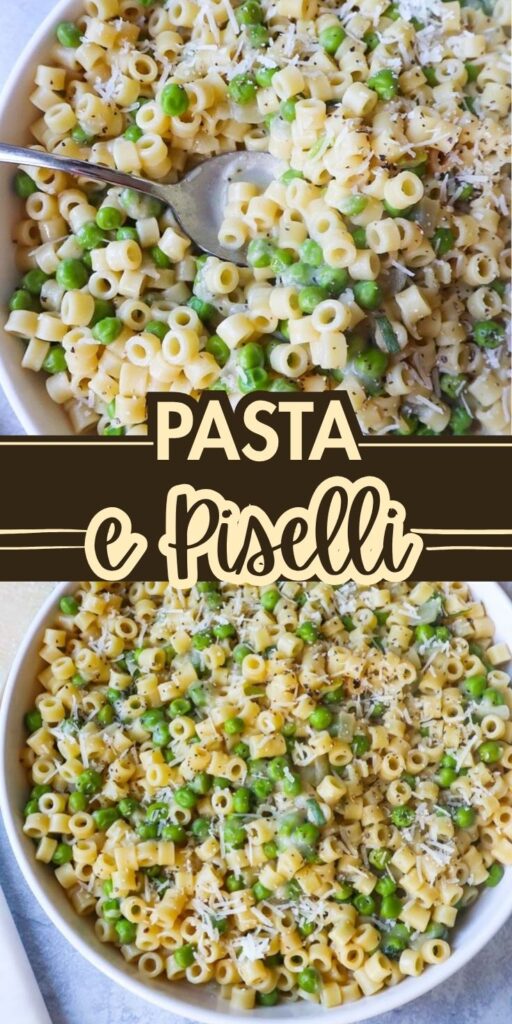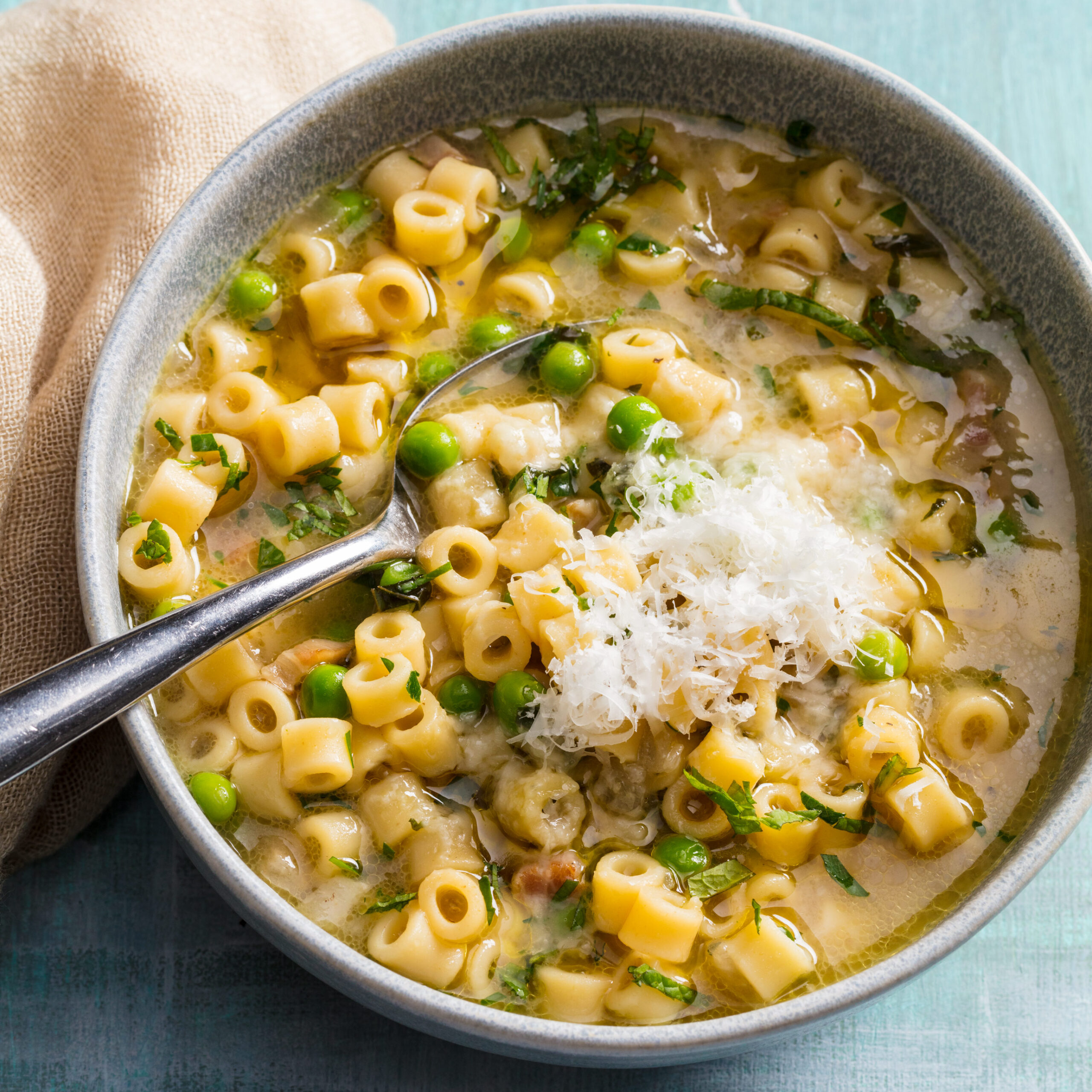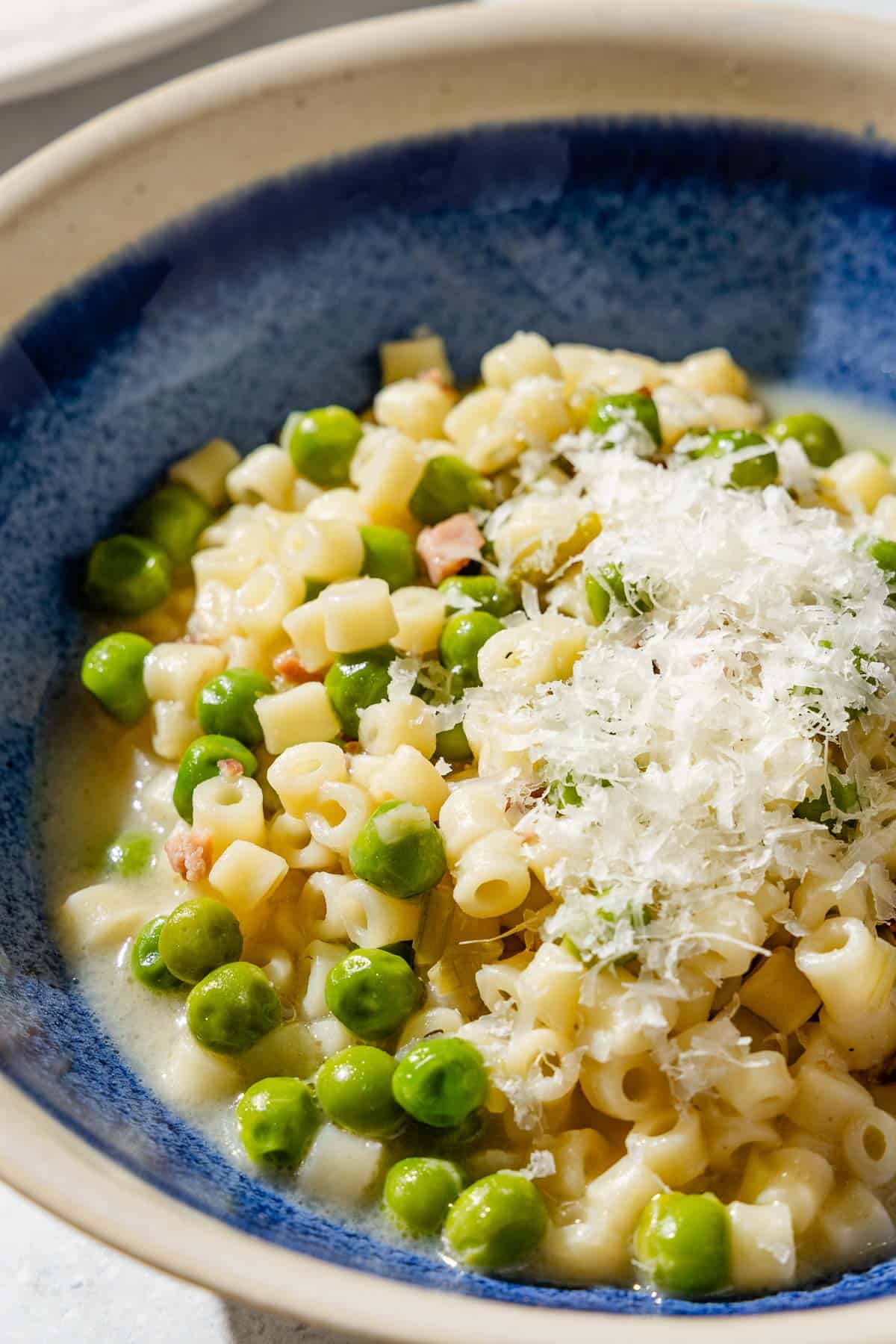Note
Pasta e Piselli, or pasta with peas, is a humble yet comforting Italian dish, traditionally made with pantry staples like pasta, green peas, onion, and Parmesan.
Despite its simplicity, a few thoughtful tips and serving tricks can elevate this meal from ordinary to extraordinary.
Tips for Making the Best Pasta e Piselli
1. Choose the Right Pasta Shape
Traditionally, Pasta e Piselli uses small shapes like ditalini, tubetti, or even broken spaghetti. These pasta types absorb the flavors better and create a risotto-like texture. If you don’t have those on hand, try elbow macaroni or orzo, but avoid long pasta like linguine or fettuccine.
2. Use Sweet Peas (Frozen or Fresh)
Frozen peas are a great choice for this recipe as they’re picked at peak ripeness. If using fresh peas, be sure to shell and cook them properly. Avoid canned peas—they tend to be too soft and dull in flavor.
3. Don’t Overcook the Peas
Add the peas halfway through cooking. Overcooking turns them mushy and grey. Cook just enough so they remain bright green and slightly sweet.
4. Create a Creamy Base (Without Cream)
One of the secrets to a luscious Pasta e Piselli is using starchy pasta water and mashing some peas during cooking. Stir vigorously to release the starch from the pasta. This technique helps achieve a creamy consistency without needing any dairy or cream.
5. Use a Flavor Base
Start with a soffritto: sauté finely chopped onion (or shallot) in olive oil or butter until translucent. Some families also add pancetta or guanciale for depth, but it’s delicious even vegetarian. Garlic can be added, but in moderation—it shouldn't overpower the sweetness of the peas.
6. Parmesan Rind Bonus
Simmer a piece of Parmesan rind in the broth while the pasta cooks. It infuses incredible umami flavor into the dish. Remove before serving.
7. Taste the Broth
Whether using water, vegetable broth, or chicken stock, make sure it’s seasoned well. The broth becomes the soul of the dish, so under-seasoning it can make everything taste flat.
8. Don’t Drain All the Liquid
Unlike traditional pasta recipes, you want Pasta e Piselli to be slightly brothy or creamy. Save that pasta water—don’t rinse or drain the pasta completely.
Serving Tricks for Pasta e Piselli
1. Serve Immediately for the Best Texture
Pasta e Piselli is best served right after cooking. Letting it sit too long can cause the pasta to absorb all the liquid and become overly soft. If that happens, add a bit of hot water or broth to loosen it back up.
2. Add Freshness with Herbs
Top with chopped fresh parsley or basil for a burst of freshness. A drizzle of lemon juice or zest can also brighten up the flavors.
3. Offer Toppings
Serve with a bowl of freshly grated Parmesan or Pecorino Romano on the side. For a little heat, offer red chili flakes or a dash of black pepper. Cracked pepper adds complexity to the mild sweetness of the peas.
4. Make It a Meal
Though hearty, you can add extra protein like shredded rotisserie chicken, poached eggs, or crispy pancetta. For a vegetarian twist, add sautéed mushrooms or artichoke hearts.
5. Store and Reheat Smartly
Store leftovers in an airtight container in the fridge for up to 2 days. When reheating, add a splash of water or broth and stir over medium-low heat to bring back the creamy consistency.
Portion and Serving Size Tips
- Standard serving: 1 to 1½ cups per person.
- Main dish: Serve with rustic bread or a side salad.
- As a side dish: Smaller portions (¾ cup) alongside grilled fish, chicken, or Italian sausages.
With its balance of comfort and simplicity, Pasta e Piselli is the perfect weeknight staple. With these tips and tricks, you can turn a simple bowl of pasta and peas into a soul-satisfying experience.
Serving Suggestions
Serve warm, garnished with a sprinkle of extra cheese, freshly cracked black pepper, and chopped fresh parsley or basil. Drizzle with a little extra virgin olive oil for richness.
Pasta e Piselli can be enjoyed as a first course (primo) in a traditional Italian meal or served as a main dish with crusty bread and a side salad.
Tips for the Best Pasta e Piselli
- Use small pasta shapes like ditalini or elbows. These hold up well and create that classic creamy texture.
- Don’t drain the pasta water! Cooking the pasta in the same pot as the peas enhances flavor and naturally thickens the dish.
- Use good cheese. Parmigiano-Reggiano or Pecorino Romano adds a bold umami kick. If you’re vegan, opt for nutritional yeast or a dairy-free alternative.
- Control the consistency. Some people like it brothy, others prefer it thicker, almost like a risotto. Adjust the water/broth to suit your taste.
Variations
- With Pancetta or Bacon:
Add ¼ cup diced pancetta or bacon at the start and cook until crispy before adding onions for a heartier version.
- With Tomato:
Add ¼ cup of tomato passata or a spoon of tomato paste after the onions for a slightly tangy twist.
- Spicy:
Add red pepper flakes or a diced chili with the garlic for heat.
- Creamier Texture:
Stir in a tablespoon of cream or mascarpone at the end.
- Gluten-Free:
Use gluten-free pasta, ensuring the cook time and liquid needs are adjusted accordingly.
Seasonal Notes
While Pasta e Piselli is available year-round (thanks to frozen peas), it’s especially delightful in spring when fresh peas are in season. It’s light enough for warm weather and cozy enough for cooler evenings.
Make-Ahead & Storage
- Make-ahead: Best enjoyed fresh, but you can prep the onion-pea base in advance and cook the pasta just before serving.
- Storage: Store leftovers in an airtight container in the fridge for up to 3 days. The pasta will continue to absorb liquid, so add a splash of water or broth when reheating.
- Freezing: Not recommended, as pasta tends to become mushy when thawed.
Final Thoughts
Pasta e Piselli is the epitome of cucina povera—Italian peasant cooking that turns basic ingredients into something soul-satisfying. Whether you’re cooking for yourself, your family, or guests, it brings comfort, warmth, and simplicity to the table.
It’s an ideal dish to customize and keep in your weeknight rotation—a bowl of green-flecked pasta that proves food doesn’t need to be fancy to be utterly delicious.


 Stir in the peas and cook for 2–3 minutes. Season with salt and pepper. If you’re using fresh peas, cook slightly longer (around 5–6 minutes) to soften.
Stir in the peas and cook for 2–3 minutes. Season with salt and pepper. If you’re using fresh peas, cook slightly longer (around 5–6 minutes) to soften. Once the pasta is cooked and the mixture is creamy (not dry), turn off the heat. Stir in the grated cheese and butter (if using) until melted and well combined. Taste and adjust seasoning again, if needed.
Once the pasta is cooked and the mixture is creamy (not dry), turn off the heat. Stir in the grated cheese and butter (if using) until melted and well combined. Taste and adjust seasoning again, if needed.

